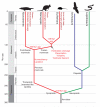Genome analysis of the platypus reveals unique signatures of evolution
- PMID: 18464734
- PMCID: PMC2803040
- DOI: 10.1038/nature06936
Genome analysis of the platypus reveals unique signatures of evolution
Erratum in
- Nature. 2008 Sep 11;455(7210):256. Nefedov, Mikhail [added]; de Jong, Pieter J [added]
Abstract
We present a draft genome sequence of the platypus, Ornithorhynchus anatinus. This monotreme exhibits a fascinating combination of reptilian and mammalian characters. For example, platypuses have a coat of fur adapted to an aquatic lifestyle; platypus females lactate, yet lay eggs; and males are equipped with venom similar to that of reptiles. Analysis of the first monotreme genome aligned these features with genetic innovations. We find that reptile and platypus venom proteins have been co-opted independently from the same gene families; milk protein genes are conserved despite platypuses laying eggs; and immune gene family expansions are directly related to platypus biology. Expansions of protein, non-protein-coding RNA and microRNA families, as well as repeat elements, are identified. Sequencing of this genome now provides a valuable resource for deep mammalian comparative analyses, as well as for monotreme biology and conservation.
Figures





References
-
- Home EA. A description of the anatomy of Ornithorynchus paradoxus. Phil. Trans. R. Soc. Lond. B. 1802;92:67–84.
-
- Bininda-Emonds ORP, et al. The delayed rise of present-day mammals. Nature. 2007;446:507–512. - PubMed
-
- Caldwell H. The embryology of Monotremata and Marsupialia. Phil. Trans. R. Soc. Lond. B. 1887;178:463–486.
-
- Griffiths M. Echidnas. Pergamon; Oxford: 1968.
-
- Griffiths M. The Biology of the Monotremes. Academic; New York: 1978.
Publication types
MeSH terms
Substances
Grants and funding
LinkOut - more resources
Full Text Sources
Other Literature Sources
Molecular Biology Databases

